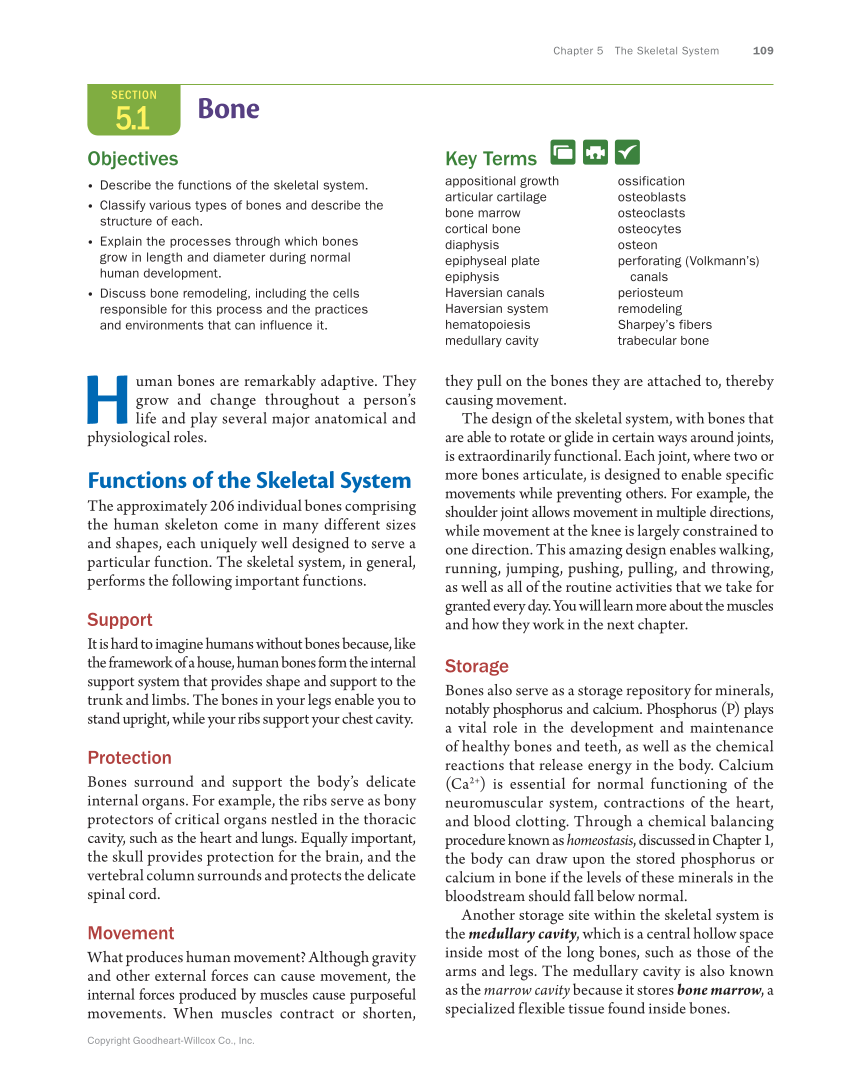Chapter 5 The Skeletal System 109 Copyright Goodheart-Willcox Co., Inc. H uman bones are remarkably adaptive. They grow and change throughout a person’s life and play several major anatomical and physiological roles. Functions of the Skeletal System The approximately 206 individual bones comprising the human skeleton come in many different sizes and shapes, each uniquely well designed to serve a particular function. The skeletal system, in general, performs the following important functions. Support It is hard to imagine humans without bones because, like the framework of a house, human bones form the internal support system that provides shape and support to the trunk and limbs. The bones in your legs enable you to stand upright, while your ribs support your chest cavity. Protection Bones surround and support the body’s delicate internal organs. For example, the ribs serve as bony protectors of critical organs nestled in the thoracic cavity, such as the heart and lungs. Equally important, the skull provides protection for the brain, and the vertebral column surrounds and protects the delicate spinal cord. Movement What produces human movement? Although gravity and other external forces can cause movement, the internal forces produced by muscles cause purposeful movements. When muscles contract or shorten, they pull on the bones they are attached to, thereby causing movement. The design of the skeletal system, with bones that are able to rotate or glide in certain ways around joints, is extraordinarily functional. Each joint, where two or more bones articulate, is designed to enable specific movements while preventing others. For example, the shoulder joint allows movement in multiple directions, while movement at the knee is largely constrained to one direction. This amazing design enables walking, running, jumping, pushing, pulling, and throwing, as well as all of the routine activities that we take for granted every day. You will learn more about the muscles and how they work in the next chapter. Storage Bones also serve as a storage repository for minerals, notably phosphorus and calcium. Phosphorus (P) plays a vital role in the development and maintenance of healthy bones and teeth, as well as the chemical reactions that release energy in the body. Calcium (Ca2+) is essential for normal functioning of the neuromuscular system, contractions of the heart, and blood clotting. Through a chemical balancing procedure known as homeostasis, discussed in Chapter 1, the body can draw upon the stored phosphorus or calcium in bone if the levels of these minerals in the bloodstream should fall below normal. Another storage site within the skeletal system is the medullary cavity, which is a central hollow space inside most of the long bones, such as those of the arms and legs. The medullary cavity is also known as the marrow cavity because it stores bone marrow, a specialized flexible tissue found inside bones. SECTION 5.1 Bone Objectives · Describe the functions of the skeletal system. · Classify various types of bones and describe the structure of each. · Explain the processes through which bones grow in length and diameter during normal human development. · Discuss bone remodeling, including the cells responsible for this process and the practices and environments that can influence it. Key Terms appositional growth articular cartilage bone marrow cortical bone diaphysis epiphyseal plate epiphysis Haversian canals Haversian system hematopoiesis medullary cavity ossification osteoblasts osteoclasts osteocytes osteon perforating (Volkmann’s) canals periosteum remodeling Sharpey’s fibers trabecular bone Ch05.indd 109 4/29/2019 11:17:09 AM
